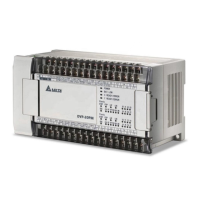3 Devices
the V
BIAS
set until the present command position of the axis specified is near the P (II) set.
V
BIAS
: D1824 (D1904, D1984); V (I): D1840 (D1920, D2000); V (II): D1844 (D1924, D2004,); V
MAX
:
D1822 (D1902, D1982); P (I): D1838 (D1918, D1998); P (II): D1842 (D1922, D2002); T
ACC
: D1836
(D1916, D1996); T
DEC
: D1837 (D1917, D1997)
Speed
T
ACC
T
DEC
V
MAX
Time
V
BIAS
Start
V(I) V(II)P(II)
P(I)
12. Bit 11 in D1846 (D1926, D2006): A mode of inserting two-speed motion is activated.
After bit 11 in D1846 (D1926, D2006) is set to 1, a mode of inserting two-speed motion will be
activated. The axis specified moves at the V (I) set. After DOG’s signal goes from low to high or
from high to low, the axis will move to the target position indicated by the P (II) set at the V (II) set.
Relative coordinates: The sign bit of the P (I) set by users determines the direction of motion.
Absolute coordinates: If the target position (P (I)) of an axis is greater than its present command
position, the motor used will rotate clockwise. If the target position (P (I)) of an axis is less than its
present command position, the motor used will rotate counterclockwise.
After motion is started, the speed of the motion will increase from the V
BIAS
set to the V (I) set. After
DOG’s signal goes from low to high or from high to low, the speed of the motion will
increase/decrease from the V (I) set to the V (II) set. If there is a transition in STOP’s signal from
low to high or from high to low when the axis specified moves at the V (II) set, the axis will stop
outputting pulses.
V
BIAS
: D1824 (D1904, D1984); V (I): D1840 (D1920, D2000); V (II): D1844 (D1924, D2004); V
MAX
:
D1822 (D1902, D1982); P (I): D1838 (D1918, D1998); P (II): D1842 (D1922, D2002); T
ACC
: D1836
(D1916, D1996); T
DEC
: D1837 (D1917, D1997)
Speed
T
ACC
DEC
V
MAX
Time
V
BIAS
Start
V(I) V(II)P(II)
DOG
13. Bit 12 inD1846 (D1926, D2006): The execution of the Ox motion subroutine set starts.
Bit 12=1: The execution of the Ox motion subroutine set starts.
Bit 12=0: The execution of the Ox motion subroutine set stops.
X-axis Y-axis Z-axis
HW LW HW LW HW LW
- D1847 - D1927 - D2007
Mode of operation
[Description]
1. Bit 2 in D1847 (D1927, D2007): Mode of sending a CLR signal
Bit 2=0: After the axis specified returns home, the CLR output will send a 130 millisecond signal to
the servo drive used, and the present position of the servo drive which is stored in a register in the
DVP-20PM Application Manual
3-60

